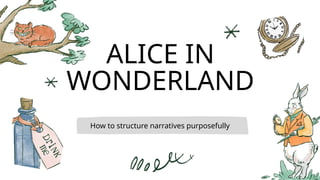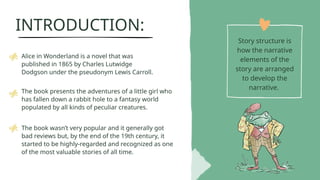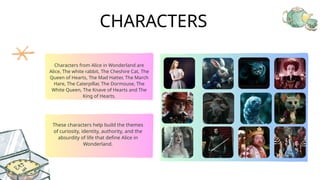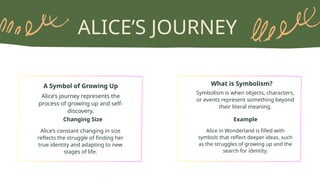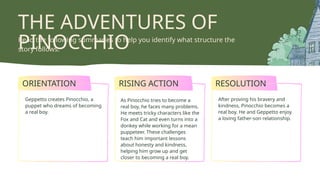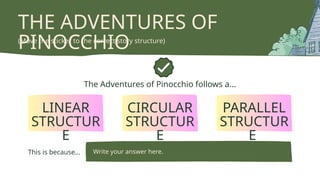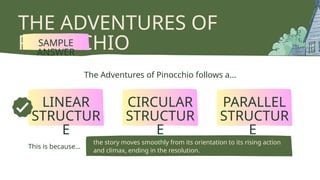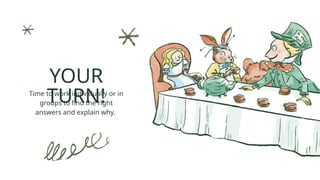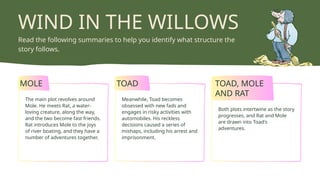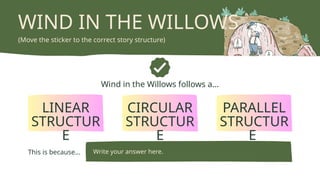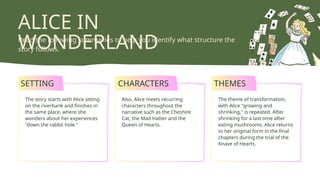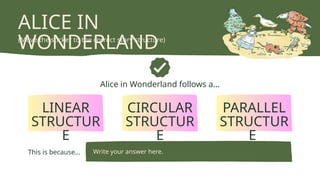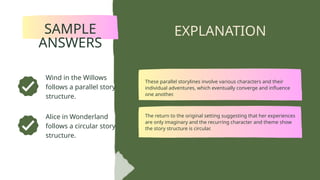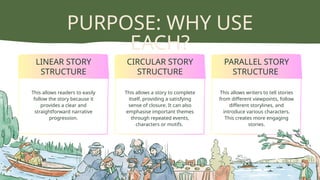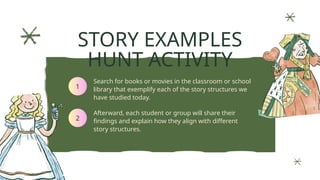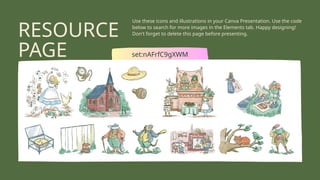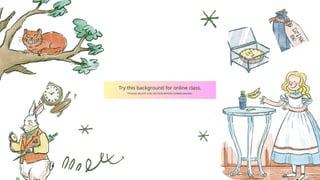Yellow Orange Abstract Cute Presentation .pdf
- 1. ALICE IN WONDERLAND How to structure narratives purposefully
- 2. INTRODUCTION: Story structure is how the narrative elements of the story are arranged to develop the narrative. Alice in Wonderland is a novel that was published in 1865 by Charles Lutwidge Dodgson under the pseudonym Lewis Carroll. The book presents the adventures of a little girl who has fallen down a rabbit hole to a fantasy world populated by all kinds of peculiar creatures. The book wasn¡¯t very popular and it generally got bad reviews but, by the end of the 19th century, it started to be highly-regarded and recognized as one of the most valuable stories of all time.
- 3. Characters from Alice in Wonderland are Alice, The white rabbit, The Cheshire Cat, The Queen of Hearts, The Mad Hatter, The March Hare, The Caterpillar, The Dormouse, The White Queen, The Knave of Hearts and The King of Hearts. CHARACTERS These characters help build the themes of curiosity, identity, authority, and the absurdity of life that define Alice in Wonderland.
- 4. ALICE¡¯S JOURNEY A Symbol of Growing Up Alice¡¯s journey represents the process of growing up and self- discovery. Changing Size Alice¡¯s constant changing in size reflects the struggle of finding her true identity and adapting to new stages of life. What is Symbolism? Symbolism is when objects, characters, or events represent something beyond their literal meaning. Alice in Wonderland is filled with symbols that reflect deeper ideas, such as the struggles of growing up and the search for identity. Example
- 5. THE ADVENTURES OF PINOCCHIO Read the following summaries to help you identify what structure the story follows. ORIENTATION RISING ACTION RESOLUTION Geppetto creates Pinocchio, a puppet who dreams of becoming a real boy. As Pinocchio tries to become a real boy, he faces many problems. He meets tricky characters like the Fox and Cat and even turns into a donkey while working for a mean puppeteer. These challenges teach him important lessons about honesty and kindness, helping him grow up and get closer to becoming a real boy. After proving his bravery and kindness, Pinocchio becomes a real boy. He and Geppetto enjoy a loving father-son relationship.
- 6. THE ADVENTURES OF PINOCCHIO (Move the sticker to the correct story structure) The Adventures of Pinocchio follows a... LINEAR STRUCTUR E CIRCULAR STRUCTUR E PARALLEL STRUCTUR E This is because... Write your answer here.
- 7. THE ADVENTURES OF PINOCCHIO The Adventures of Pinocchio follows a... LINEAR STRUCTUR E CIRCULAR STRUCTUR E SAMPLE ANSWER PARALLEL STRUCTUR E This is because... the story moves smoothly from its orientation to its rising action and climax, ending in the resolution.
- 8. Time to work individually or in groups to find the right answers and explain why. YOUR TURN!
- 9. MOLE TOAD TOAD, MOLE AND RAT WIND IN THE WILLOWS Read the following summaries to help you identify what structure the story follows. The main plot revolves around Mole. He meets Rat, a water- loving creature, along the way, and the two become fast friends. Rat introduces Mole to the joys of river boating, and they have a number of adventures together. Meanwhile, Toad becomes obsessed with new fads and engages in risky activities with automobiles. His reckless decisions caused a series of mishaps, including his arrest and imprisonment. Both plots intertwine as the story progresses, and Rat and Mole are drawn into Toad's adventures.
- 10. LINEAR STRUCTUR E CIRCULAR STRUCTUR E PARALLEL STRUCTUR E WIND IN THE WILLOWS (Move the sticker to the correct story structure) This is because... Write your answer here. Wind in the Willows follows a...
- 11. SETTING CHARACTERS THEMES ALICE IN WONDERLAND Read the following summaries to help you identify what structure the story follows. The story starts with Alice sitting on the riverbank and finishes in the same place, where she wonders about her experiences "down the rabbit hole." Also, Alice meets recurring characters throughout the narrative such as the Cheshire Cat, the Mad Hatter and the Queen of Hearts. The theme of transformation, with Alice "growing and shrinking," is repeated. After shrinking for a last time after eating mushrooms, Alice returns to her original form in the final chapters during the trial of the Knave of Hearts.
- 12. LINEAR STRUCTUR E CIRCULAR STRUCTUR E PARALLEL STRUCTUR E ALICE IN WONDERLAND (Move the sticker to the correct story structure) This is because... Write your answer here. Alice in Wonderland follows a...
- 13. Alice in Wonderland follows a circular story structure. Wind in the Willows follows a parallel story structure. These parallel storylines involve various characters and their individual adventures, which eventually converge and influence one another. The return to the original setting suggesting that her experiences are only imaginary and the recurring character and theme show the story structure is circular. EXPLANATION SAMPLE ANSWERS
- 14. LINEAR STORY STRUCTURE CIRCULAR STORY STRUCTURE PARALLEL STORY STRUCTURE PURPOSE: WHY USE EACH? This allows readers to easily follow the story because it provides a clear and straightforward narrative progression. This allows a story to complete itself, providing a satisfying sense of closure. It can also emphasise important themes through repeated events, characters or motifs. This allows writers to tell stories from different viewpoints, follow different storylines, and introduce various characters. This creates more engaging stories.
- 15. 1 2 STORY EXAMPLES HUNT ACTIVITY Search for books or movies in the classroom or school library that exemplify each of the story structures we have studied today. Afterward, each student or group will share their findings and explain how they align with different story structures.
- 16. set:nAFrfC9gXWM RESOURCE PAGE Use these icons and illustrations in your Canva Presentation. Use the code below to search for more images in the Elements tab. Happy designing! Don't forget to delete this page before presenting.
- 17. Try this background for online class. *PLEASE DELETE THIS SECTION BEFORE DOWNLOADING.
- 18. B for blur C for confetti D for a drumroll M for mic drop O for bubbles Q for quiet U for unveil Any number from 0-9 for a timer PRESS THESE KEYS WHILE ON PRESENT MODE!
